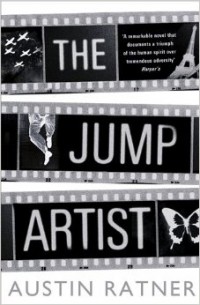Retinas oxidized in the ether
 The Jump Artist
The Jump Artist
by Austin Ratner
Although I knew that this novel was based on a true story, it was only in the last few pages that I realised I knew a little of its subject, Philippe Halsman, and his famous photographs. Which was perhaps for the best, because it meant that the story was new to me. But I don’t think it would matter if you already knew the story, because the writing is by far good enough to keep you enraptured.
The story begins with Philippe and his father on a walking holiday in the Austrian Alps in 1928. By the end of the day Philippe has been accused of murder and his subsequent trial and retrial reverberate throughout the world’s press. Halsman was a Latvian Jew, an intense, brooding, depressive man in a bewildering world of anti-Semites. Great thinkers of the day, including Albert Einstein, Thomas Mann and Sigmund Freud spoke up on his behalf and he later became a celebrity photographer, but the murder and the imprisonment could never be struck from Halsman’s memory.
Ratner has done an excellent job of combining extensive research, with extracts from diaries, newspapers and other first-hand sources throughout the text, and yet he has still created a living breathing character in Halsman. He is not even a sympathetic character, at least not at first, though considering the seemingly hopeless situation you can forgive him for the flights of crazy. He self-harms, invents methods of self-punishment including starvation, and disappears into his own dark dark world of death and guilt and shame. Extracts from Halsman’s letters from prison reveal his slightly scary intensity and Ratner captures this in his own prose:
“When he’d seen Winged Victory on the Daru staircase at the Louvre, Papa and Mama and Liouba had had to leave him behind to go see the Persian friezes. He’d soaked up the pleasure of it in his eyes for more than an hour, and when he looked at his face in the mirror at the hotel, his eyes were wrecked with burst vessels.”
Despite this dark central character, and indeed the dark times covered, from 1920s Austria to 1930s Paris and the great exodus of 1940, this book didn’t depress me. In fact, the one time I cried it was at a beautiful moment of humanity. I was so engrossed that I powered straight through in just a couple of sittings, and then wished that I had lingered over it, savoured the often exquisite language:
“They’d been up at 5:30 that very morning and vaulted up the Schönbichlerhorn into its frigid airless winds, had their retinas oxidized in the ether, and their hands seared on the snow and the flint rocks, hot as sunburned metal. They had broken themselves on the mountain and been baptized there above the timber line at the top of the world, where the river of air meets the river of fire.”
In later chapters, I loved the descriptions of Halsman taking photographs and could often picture the finished result from Ratner’s description. From tentative beginnings, Halsman finally finds confidence and artistry in photography and Ratner evokes a believably troubled but brilliant man.
I am not sure why, after this was published to great acclaim in the US in 2009, it took three years to find a UK publisher, but I am really glad that it now has.
This book was kindly sent to me by the publisher in return for an honest review.
First published in the USA in 2009 by Bellevue Literary Press.
Winner of the 2010 Sami Rohr Prize for Jewish Literature.
Published in Great Britain in 2012 by Viking, an imprint of Penguin Books.
Hello from a fellow Penguin Proof Group blogger. Great review! Sounds like a fascinating story and a beautifully written book. I’ll have to add it to my (already-much-too-long) list of books to read 🙂
VictoriaH Hello! And yes, that TBR never does get shorter 🙂